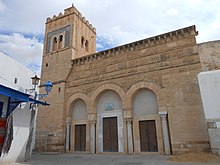Mosque of the Three Doors
| Mosque of Three Doors | |
|---|---|
مسجد الأبواب الثلاثة | |
 | |
| Religion | |
| Affiliation | Sunni Islam |
| Location | |
| Location | Kairouan, Tunisia |
| Geographic coordinates | 35°24′13″N 10°03′40″E / 35.4037°N 10.0610°E |
| Architecture | |
| Type | Mosque |
| Creator | Muhammad ibn Khairun |
| Completed | 866 |
The Mosque of Three Doors (Arabic: مسجد الأبواب الثلاثة; French: Mosquée des Trois Portes) or Mosque of Muhammad ibn Khairun (Arabic: مسجد ابن خيرون) is a mosque In the city of Kairouan, Tunisia.[1] Commissioned by Muhammad ibn Khairun in 866, it is one of the oldest mosques in the world, and one of the oldest existing testament to the Aghlabid-era architectural design.
History
Muhammad ibn Khairun was a traveller and reader of Quran, who came to Kairouan after visiting multiple places such as Baghdad and Cairo. In Kairouan he established a mosque for studying the scripture.
Architecture
The mosque is characterized by the central structure consisted of three doors and horseshoe arches which resemble that of the Mosque of Uqba,[2] and the engraving of floral and geometric patterns, and the inscriptions written in the Kufic. Despite the fact that the Kufic is extensively used as an decorations for Islamic architecture, engraving of the inscription on the building is a rare case. These architecture design of the Aghlabids can be characterized from the inheritance of the local architectural tradition and the simultaneous recognition of the Abbasid metropolitan styles and techniques.[3] The mosque contains musholla (prayer room) with three vaults and paralleled with qibla wall, and three water basins with crowned pillars. It is also attached with a square-shaped minaret which is a later addition during the Hafsid era.
See also
References
- ^ "Discover Islamic Art - Virtual Museum - monument_ISL_tn_Mon01_26_fr". www.discoverislamicart.org. Retrieved 2018-01-30.
- ^ Petersen, Andrew. (2002) Dictionary of Islamic Architecture. p.24.
- ^ Bloom, Jonathan M. Blair, Sheila S. (2009) The Grove Encyclopedia of Islamic Art and Architecture. Oxford University Press. p.86.


